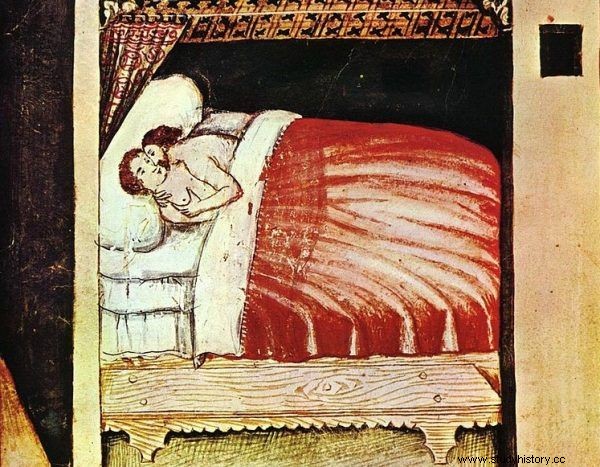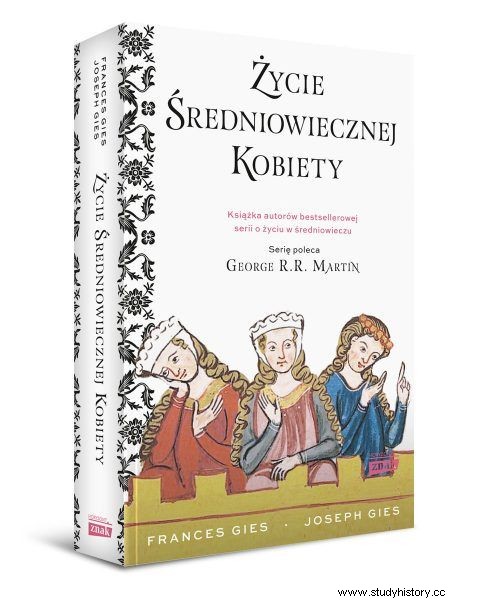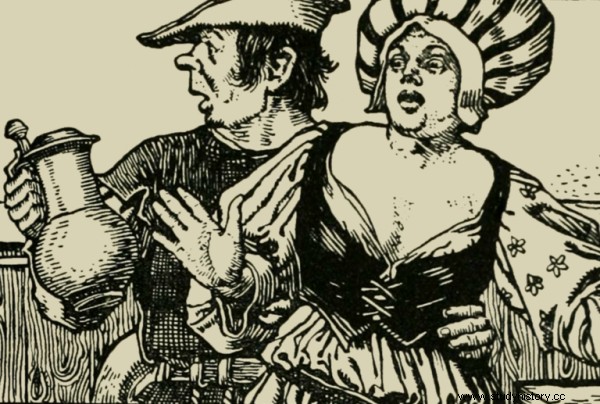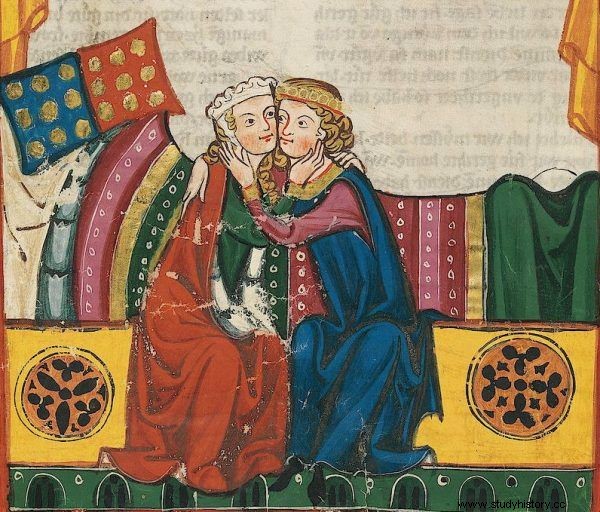the burning of the woman was to guarantee her marital fidelity
Religion had a great influence on the minds of the people of the Middle Ages. Bible quotations were a source of inspiration for the writers of the day, and intellectuals argued using arguments drawn from the Old and New Testaments. The tradition of referring to the Holy Scriptures was very vivid - it was simply not imagined that any important area of human activity would not be based on it.
It was of great importance for the social position of the fair sex. As Frances and Joseph Gies emphasize in their latest book "The Life of a Medieval Woman", Saint Paul used to say that:" It is good for a man not to connect with a woman ”(It is wondering whether the apostle deliberately separated women from men in this sentence - that is, men). His example was followed by the medieval clergy.
A stain on honor
One of the French archbishops noted:devil - ed. B.S.] has pledged us […] the worst is a woman, a limp stem, a satanic root, a wicked face […] honey and poison ”. And even if this godly man only spoke of prostitutes that way, it did say quite a bit about his general attitude towards women.

Double standards were applied to cheating spouses in the Middle Ages. The man was almost unpunished while the woman faced severe consequences.
Besides, he was not the only one who had a similar opinion about the white-headed people - and it was not without significance for the law and customs at that time, especially those concerning ... marital infidelities. There is no doubt that medieval laws treated women differently than men. Frances and Joseph Gies note that:
Kings, barons, knights, and wealthier townspeople openly supported mistresses and produced illegitimate children, while sinful women were disgraced and chased away (…). The wife's infidelity was not seen as an offense against morality but as a detriment to the husband's honor.
Spanish law from the 13th century stated that a husband or fiancé could kill a woman and her lover without paying a fine for the murder or sentenced to death, but in some municipalities In fourteenth-century Italy, the adulterating women were flogged, chasing them down the streets and driving them out of the city.
The conduct of the King of the Franks, Charlemagne, was a perfect example of the application of such double standards in matters of marital fidelity. Well, he renounced his first wife, and after his fifth death, instead of entering into another official relationship, he maintained relations with four concubines. And there would be nothing particularly outrageous about it, if not for the fact that at the same time this ruler introduced a law in his country that prohibited the annulment of marriages on the grounds of adultery. In that case, the husband could walk away from his unfaithful wife and place severe sanctions on her.

The text is based on the latest volume of the best-selling series by Francis and Joseph Gies "The Life of a Medieval Woman" , which was released by the Znak Horyzont publishing house.
The punishment (in) proportionate to the blame
As for the punishments faced by women of that time for succumbing to impulsive hearts and marital dishonesty, they were usually extremely cruel. There have been cases, however, where redemption was achieved with money. A fine for an adulterous wife was stipulated, for example, by laws in medieval Wales.
Importantly, under Welsh law, any physical contact of the partner with a foreign man was a sufficient reason to demand compensation from the unbeliever. A simple kiss was enough to be accused of treason, although when the traitors were caught in bed, much higher amounts were awarded, so it was "profitable" to wait for the vicious relationship to be consumed.
There were, however, exceptions to these rules. A woman could count on more gracious treatment if the suspicious touching or exchanging kisses occurred while playing or if the stranger turned out to be ... a foreigner unfamiliar with the law and local customs.
However, in most of the countries of medieval Europe, the consequences of treason were much more serious. This was due to the fact that the institutions of Roman law had a huge impact on the codes of that time. The responsibility for the maintenance of extramarital relations was of course solely borne by the wife .

If the husband caught his wife cheating, he could have killed her on the spot.
If she was caught red-handed, her husband could have killed her on the spot. There were also penalties for putting a naked woman under a pillory or placing an adulteress on a donkey and driving around the city to make her the object of a mockery. It was all the more humiliating as this animal symbolized the utmost disgrace.
In turn, among the Slavs, it was customary to burn women at the stake with their deceased spouses. It is often interpreted to mean that the wife's love for her husband was so great that after her beloved had passed away, the woman could no longer live. However, there is also another explanation for this. Some researchers speculate that the burning of the woman was supposed to guarantee her marital fidelity . Therefore, it can be assumed that in such circumstances a specific prevention was operating.
Fear God's wrath
The brutality of the sentences for adultery was somewhat alleviated only under the influence of canon law. It was opposed in principle to the death penalty, and in its place recommended penance, which was to take place in a monastery. Treason was treated as a public crime, because by ruining the family it became dangerous for the Christian society.
The so-called presumptions were used in trials for marital dishonesty. They were divided into two groups. The first included those that did not require proof. It was assumed that a betrayal had certainly taken place if a woman became pregnant during her husband's long illness or his absence, or if his partner , after having warned a stranger three times, nevertheless found him with his wife in a bed, closed room or other secluded place.

Physical contact between a woman and a stranger - even an innocent kiss - was enough to be accused of treason.
The second group included the presumptions that had to be proved. This included situations where a woman was joking and laughing in the presence of a man other than her husband, when they exchanged gifts, letters, kisses or other indecent touches. Naturally, the same did not apply to the gentlemen - they were free to flirt behind their wife's back, and the possible consequences of their betrayals did not take the form of bloody vengeance and - even worse - divine condemnation ...
Punishment in the form of flogging, exile or shame on a donkey for medieval people was nothing in the face of the most severe consequences of transgressions against the sacred institution of marriage. As often as death, young married women and women showing a tendency to "jump to the side" were threatened with God's wrath and hellfire . It is difficult to say which of these potential consequences was the more effective bogeyman.
However, it is worth noting at this point that marital infidelity and the accompanying loosening of morals were not always stigmatized in the Middle Ages as the absolute greatest crime that the fair sex could commit. Describing everyday life in the time of Joan of Arc, Marcelin Defourneaux cited a story like this:
The Knight de la Tour Landry cites his daughters as an example of three women, two of whom were irrevocably condemned for having too many dresses and wearing makeup, and the third who sometimes she slept with a certain squire - it was nine or twelve times, she went to purgatory.

The text is based on the latest volume of the best-selling series by Francis and Joseph Gies "The Life of a Medieval Woman" , which was released by the Znak Horyzont publishing house.
Despite the fact that women in the Middle Ages did not have equal status to men, as evidenced by the examples of punishing them for treason, one should agree with Frances and Joseph Gies, who in the book "The Life of a Medieval Woman" emphasize the important role of the fair sex in that era. However, these insightful scholars of the history of the dark ages also recognize that the voice of the ladies was then almost inaudible. Completely unique in these circumstances was the figure of Christine de Pisan, a poet who lived and worked at the court of Charles VI the Mad at the end of the 14th century:who stood on behalf of women and was aware of their special role and living conditions. In fact, she was one of the few true feminists before the modern era. (...) Christine became convinced that every rational husband must value, love, adore a woman. (...) She is his mother, sister, friend; he shouldn't treat her like an enemy.
Such appeals were intended to change the attitude of men towards women, and at the same time to alleviate the penalties imposed on women for actual and alleged offenses. However, it took a long time to finally hear them…
Bibliography:
- M. Defourneaux, Everyday Life in the Time of Joan of Arc , PIW 1963.
- F. Gies, J. Gies, The Life of a Medieval Woman , Znak Horyzont 2019 Publishing House.
- K. Jaworska-Biskup, Marriage and divorce in medieval law Hywel Dda (Cyfraith Hywel) , "Journal of Law and History", vol. LXVI, issue 2, 2014.
- R. Krajewski, Sexual rights and obligations of spouses. Legal study of the norm and pathology of behavior , Wolters Kluwer 2009.
Check where to buy "The Life of a Medieval Woman":
